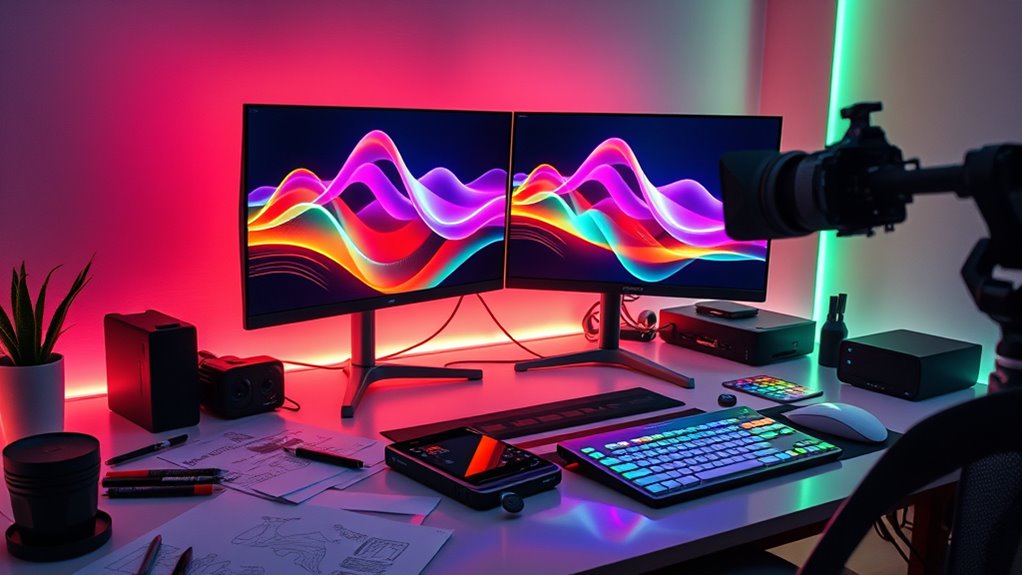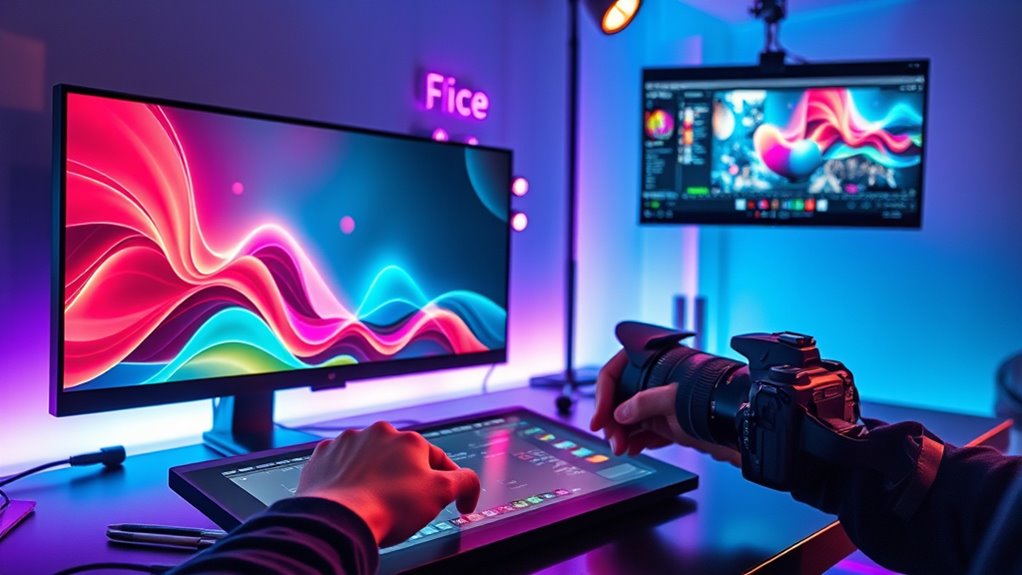To design engaging motion graphics for aftermovies and recaps, focus on enhancing storytelling by aligning visuals with the event’s energy and mood. Use dynamic shifts, animated text, and visual cues to highlight key moments, while maintaining a cohesive color palette to create a polished look. Balance effects to support the narrative without overwhelming viewers. If you keep exploring, you’ll discover how to craft visuals that truly elevate your recap’s impact.
Key Takeaways
- Align graphic styles and animations with the event’s mood to enhance storytelling and emotional impact.
- Use cohesive color schemes that complement footage and reinforce the overall vibe.
- Balance animated text, icons, and overlays to support key moments without overwhelming viewers.
- Incorporate transitions, effects, and visual cues to guide viewers seamlessly through the narrative.
- Ensure all motion graphics work harmoniously with footage for a polished, professional look.

Creating compelling aftermovies and recaps requires more than just editing footage; it demands engaging motion graphics that capture the event’s energy and essence. When you’re designing motion graphics, your goal is to enhance the story you’re telling, making viewers feel as if they’re reliving the moment. Visual storytelling becomes your guiding principle—using graphics, smooth transitions, and effects to convey emotion, highlight key moments, and set the tone. To do this effectively, you need to pay close attention to color grading, which dramatically influences the mood and atmosphere of your recap. Color grading is not just about making footage look good; it’s about creating a cohesive visual language that aligns with the event’s vibe. Warm tones can evoke excitement and intimacy, while cooler hues might emphasize calmness or nostalgia. When you integrate color grading seamlessly with your motion graphics, your recap transforms from a simple montage into an immersive experience.
Additionally, understanding the importance of visual cohesion helps ensure that all elements work together harmoniously, reinforcing the overall emotional impact of the recap.
To start, think about how your graphics can support the narrative. For example, if the event was lively and energetic, use bold, dynamic animations and vibrant colors. Conversely, for a more subdued or elegant event, opt for sleek, minimalistic graphics with softer color palettes. Your motion graphics should act as visual cues, guiding viewers through the story without overwhelming them. This means balancing the use of animated text, icons, and overlays with the footage itself. When applying color grading, guarantee that your graphics complement the overall color scheme, maintaining harmony and consistency. This consistency helps reinforce the event’s mood and makes the recap feel polished and professional.
Frequently Asked Questions
What Software Tools Are Best for Creating Motion Graphics?
You should consider Adobe After Effects as your primary tool for creating motion graphics, as it excels in visual effects and complex typography techniques. Blender is also a great option for 3D elements, while Apple Motion offers a user-friendly alternative for Mac users. These software tools give you the flexibility to craft dynamic visuals, enhance storytelling, and produce engaging aftermovies and recaps effortlessly.
How Do I Choose the Right Color Palette for Aftermovies?
Did you know that color harmony can boost viewer engagement by up to 80%? To choose the right palette for aftermovies, focus on the mood you want to set—energetic for festivals or emotional for heartfelt moments. Use complementary or analogous colors for harmony, ensuring your visuals evoke the desired feelings. Keep it consistent with your brand or event theme, and test different combinations to see what resonates best with your audience.
What Is the Ideal Duration for Motion Graphics in Recaps?
The ideal duration for motion graphics in recaps is around 10-15 seconds per segment. You should focus on maintaining good video pacing to keep your audience engaged without overwhelming them. Short, dynamic graphics work best, allowing you to highlight key moments while keeping the energy high. By balancing timing and visuals, you’ll ensure your recap stays lively and captures viewers’ attention throughout.
How Can I Incorporate Branding Seamlessly Into Motion Graphics?
They say “a picture is worth a thousand words,” and that’s true for brand integration. You can seamlessly incorporate branding into motion graphics by maintaining visual consistency with your brand’s colors, fonts, and style. Use subtle logo placements and cohesive design elements that blend naturally with the overall aesthetic. This approach guarantees your brand stands out without overpowering the content, creating a polished, professional look that resonates.
What Are Common Pitfalls to Avoid in Motion Graphic Design?
You should avoid visual clutter by keeping your design clean and focused, so your message isn’t lost. Also, watch out for inconsistent pacing; make sure your motion flows smoothly to keep viewers engaged. Rushing through elements or dragging scenes can disrupt the rhythm. Be mindful of overusing effects or text, which can overwhelm your audience. Clear, balanced motion keeps your graphics professional and compelling.
Conclusion
Now that you know how to craft eye-catching motion graphics for aftermovies and recaps, you’re ready to turn moments into visual masterpieces. With your creativity and these techniques, your work will stand out brighter than a superstar at a concert. Remember, every detail counts—like a spark that ignites the entire show. So go ahead, release your skills, and make your recaps unforgettable; after all, you’re the artist turning memories into magic!










